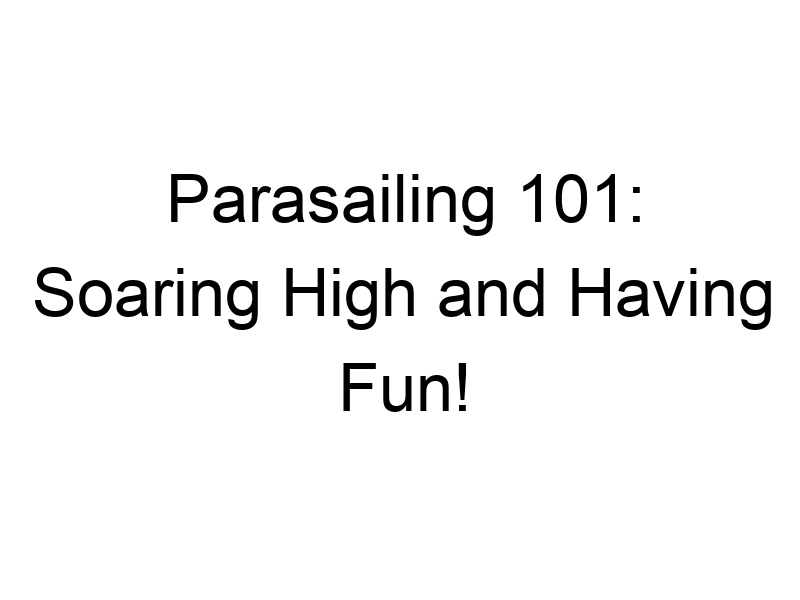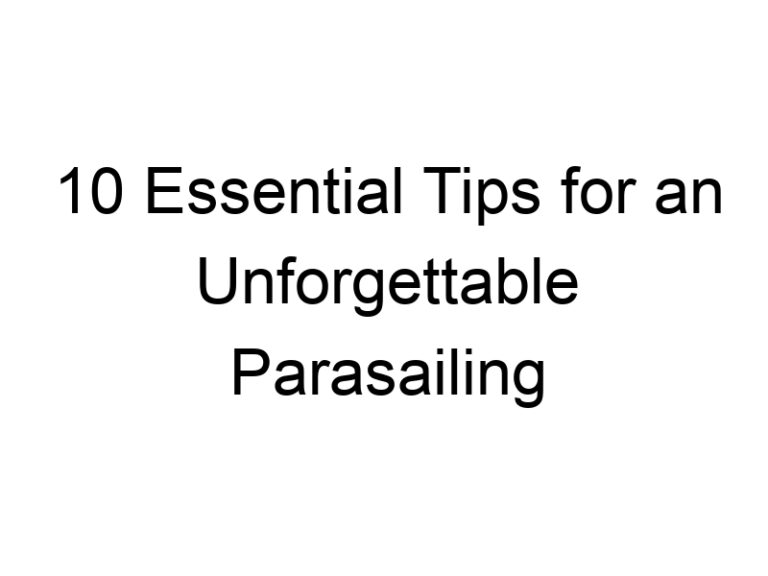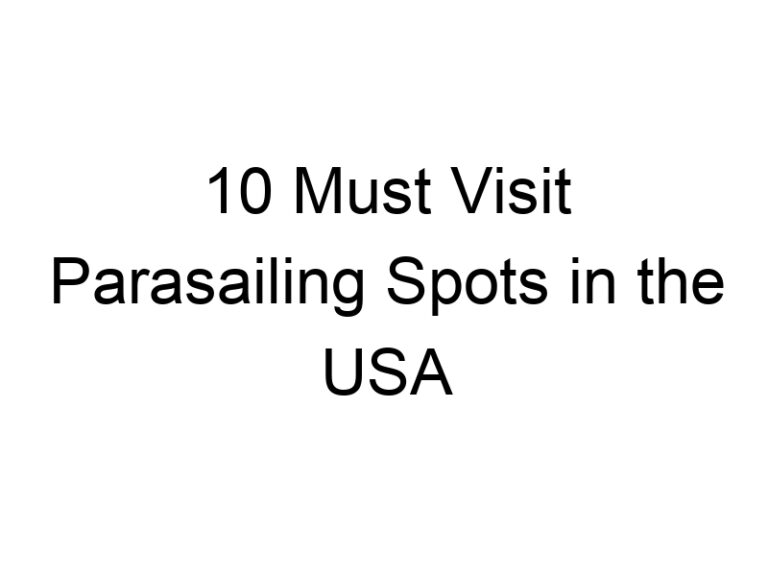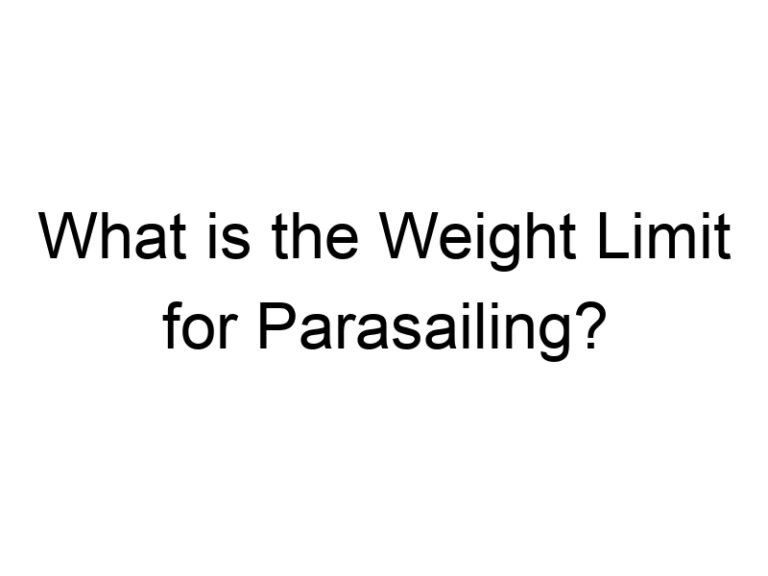Ever looked at the ocean and thought, “What if I could fly over that?” Well, parasailing is the answer. It’s that amazing activity where you’re harnessed to a parachute and towed by a boat, letting you glide above the water. Sounds fun, right? This guide, Parasailing 101: Soaring High and Having Fun!, is here to walk you through everything you need to know about this thrilling sport. Whether you’re a newbie or a thrill-seeker, there’s something here for everyone.
Key Takeaways
- Parasailing is a fun activity where you’re towed behind a boat while attached to a parachute.
- Safety is a top priority, and most places have experienced crews and certified equipment.
- You don’t need to be an athlete to parasail; it’s accessible to almost everyone.
- Best enjoyed in coastal areas with beautiful views, like beaches and lakes.
- Always check the weather and follow the crew’s instructions for a safe experience.
What is Parasailing?

Parasailing is a thrilling outdoor activity where participants are towed behind a boat while attached to a specially designed parachute, known as a parasail. This adventure lets you soar high above the water, offering breathtaking views and a unique perspective of the surrounding landscape.
How Does Parasailing Work?
- Preparation and Setup: Before you take off, you’ll be fitted with a harness that connects you to the parasail. The parasail is securely attached to the boat with a tow rope.
- Takeoff: As the boat accelerates, the wind fills the parasail, lifting you gently off the deck into the air.
- Flight: Once airborne, you’ll glide smoothly, enjoying the views. The boat controls the altitude by adjusting speed.
- Landing: To land, the boat slows down gradually, allowing you to descend back to the deck or gently into the water, depending on the method used.
Key Features of Parasailing
- Single or Tandem Flights: You can parasail alone or with one or two companions.
- Altitude: Typically, parasailers fly at heights ranging from 500 to 800 feet, providing a bird’s eye view of the scenery.
- Duration: Flights usually last between 10 to 15 minutes, depending on the package and weather conditions.
Imagine the thrill of being up in the air, the wind in your hair, and the world spread out beneath you. Parasailing offers an unforgettable experience that combines the joy of flying with the serenity of floating above the water.
History of Parasailing
Parasailing, a thrilling water sport, has an intriguing history that dates back to the early 1960s. The origins of parasailing can be traced back to a French parachute instructor named Pierre Lemoigne. Lemoigne, seeking a new method to train parachutists, stumbled upon the idea of towing a parachute behind a vehicle to lift it into the air. This innovative approach allowed his students to experience the sensation of parachuting without the complexities of an airplane jump.
The Birth of a New Sport
Initially, Lemoigne used cars to pull the parachutes, but the concept quickly evolved. By tying a parachute to a vehicle, he inadvertently laid the groundwork for what would become parasailing. This method was not only cost-effective but also safer than traditional airplane jumps, making it popular among his students.
Evolution and Innovation
Fast forward to the summer of 1969, when another pioneer, Brian Gaskin, began experimenting with ex-military parachutes. Gaskin aimed to bring the excitement of flight to his family’s boating trips. Realizing the need for a parachute specifically designed for parasailing, he created the “Waterbird” in 1974, marking a significant advancement in the sport’s equipment.
Modern Developments
Gaskin’s “Waterbird” set the standard for parasailing equipment. His company, Waterbird Parakites, became a cornerstone in the parasailing industry, continually improving the design and safety of parasails. Today, parasailing is enjoyed worldwide, offering enthusiasts the chance to soar high above the water, experiencing the thrill that Lemoigne and Gaskin first envisioned.
How Parasailing Works
Parasailing is a unique adventure sport that combines elements of parachuting and boating to offer a thrilling experience. Understanding how parasailing works can make the experience even more enjoyable.
The Basics of Parasailing Mechanics
At its core, parasailing involves being towed behind a boat while attached to a specially designed parachute, known as a parasail. Here’s a simple breakdown of how it all comes together:
- The Boat: A powerful boat, often equipped with a winch system, is used to tow the parasail. The speed and direction of the boat control the flight path.
- The Parasail: This is a parachute-like canopy that catches the wind, allowing you to soar into the air. It’s connected to the boat by a long tow rope.
- The Harness: You’ll wear a harness that connects you securely to the parasail. This harness is designed for comfort and safety, ensuring you’re snugly attached during your flight.
How Does Parasailing Work?
The process begins on the boat’s deck. You’ll be fitted with a harness and then attached to the parasail. As the boat accelerates, the parasail catches the wind, and you gently lift off the deck. It’s a smooth ascent, and soon enough, you’re gliding high above the water.
The boat maintains a steady speed, which keeps you airborne. You’ll feel the wind in your face and enjoy panoramic views of the surrounding landscape. The height can vary, but typically, parasailers fly between 200 to 500 feet above the water.
Landing
When it’s time to return to the boat, the winch system slowly reels you back in. You’ll descend gradually, landing softly on the boat’s deck. It’s a seamless process that ensures a gentle and safe return.
Parasailing offers a unique perspective of the world below, blending the thrill of flight with the tranquility of floating in the sky. Whether you’re an adrenaline junkie or just seeking a new way to enjoy the scenery, parasailing provides an unforgettable experience.
Understanding these parasailing mechanics can enhance your appreciation for this exciting activity. It’s not just about the thrill; it’s about the seamless blend of nature and technology that makes it all possible.
Equipment Needed for Parasailing

When it comes to parasailing, having the right gear is essential for both safety and enjoyment. Here’s a rundown of the key pieces of parasailing equipment you’ll need:
- Parasail: This is the specially designed parachute that lifts you into the air. It’s crucial to ensure that the parasail is in excellent condition and suitable for the weather conditions.
- Harness: The harness is what keeps you attached to the parasail. It should fit snugly and be comfortable, as you’ll be wearing it throughout the flight.
- Tow Rope: This is the line that connects the parasail to the boat. It’s typically made from durable materials to withstand the tension and weight.
- Winch System: The winch system is on the boat and is used to reel the parasail in and out. It allows for smooth takeoffs and landings.
- Life Jacket: Safety first! A life jacket is a must, ensuring that you’re safe even if you end up in the water.
- Tripleizer Bar: This piece of equipment helps distribute weight evenly, especially when more than one person is parasailing.
Remember, the quality and condition of your equipment can make or break your parasailing experience. Always check your gear thoroughly before heading out.
For those looking to explore a range of parasailing equipment, including winch systems, parachutes, tow ropes, harnesses, tripleizer bars, and life jackets, it’s crucial to ensure everything is up to standard for a safe and enjoyable adventure.
Safety Measures in Parasailing
Parasailing is an exhilarating adventure, but like any outdoor activity, it comes with its own set of risks. Ensuring safety is crucial to enjoying this experience without a hitch. Here are some key parasailing precautions to keep in mind:
- Choose a Reputable Operator: It’s essential to select a parasailing company with a strong safety record. Look for operators who are certified and have experienced crew members. Checking reviews and asking about their safety protocols can give you peace of mind.
- Weather Awareness: Always be mindful of the weather conditions before heading out. Avoid parasailing during storms, high winds, or other adverse weather situations. A good operator will cancel trips if conditions aren’t safe.
- Inspect Equipment: Before you take off, ensure that all equipment, including the harness and parasail, is in excellent condition. Any signs of wear and tear could be a red flag.
- Follow Instructions: Listen carefully to the pre-flight briefing provided by the crew. They will guide you on how to safely take off, fly, and land. Following their instructions is vital for a smooth experience.
- Proper Attire: Wear a life jacket and appropriate clothing. Quick-dry clothes and secure footwear are ideal since you might get wet.
- Weight Limits: Adhere to the weight limits specified by the operator. Overloading the parasail can be dangerous.
Safety first! Parasailing can be a thrilling experience, but it’s important to prioritize safety above all else. By following these precautions, you can enjoy the ride and the breathtaking views without worry.
Remember, when it comes to parasailing, preparation and caution go a long way in ensuring a fun and safe adventure. Always select a reputable operator and keep these safety measures in mind for a memorable experience.
Best Locations for Parasailing
Dreaming of the best parasailing destinations? Let’s dive into some top spots where you can catch the breeze and enjoy the view.
- Destin, Florida: Known for its emerald waters and sandy beaches, Destin is a parasailing paradise. The experience here is enhanced by the stunning backdrop of the Gulf of Mexico. Companies like Xtreme H2O Sports offer competitive prices and experienced captains to ensure a safe adventure.
- Hawaii: Imagine soaring over the vibrant blue waters with a view of volcanic islands. Places like Maui and Oahu offer breathtaking parasailing experiences that are hard to beat.
- Orange Beach, Alabama: This Gulf Coast gem offers a unique parasailing experience. The views of the Alabama shoreline, coupled with the chance to spot dolphins and sea turtles below, make this a memorable location.
Parasailing offers a unique perspective on some of the world’s most beautiful coastal destinations. Whether you’re gliding over the serene waters of Florida or the dramatic coastlines of Hawaii, the experience is unforgettable.
- California: With its diverse coastlines, from the rocky cliffs of Big Sur to the sandy shores of San Diego, California provides varied parasailing adventures.
- Thailand: Known for its exotic beaches, Thailand offers parasailing in places like Phuket and Pattaya. The tropical scenery is unmatched, making it a top choice for thrill-seekers.
These destinations offer more than just a ride in the sky—they promise memories that last a lifetime. So grab your gear, and get ready to soar!
Parasailing Techniques and Tips
Parasailing is a thrilling adventure that combines the joy of flying with breathtaking views. Whether you’re a seasoned thrill-seeker or a complete newbie, mastering a few techniques can make your experience even more enjoyable. Here’s your parasailing adventure guide to ensure a memorable and safe flight.
Launching and Landing
- Launching: Start by sitting on the deck of the boat, securely strapped into your harness. As the boat speeds up, you’ll feel a gentle lift as the parasail catches the wind. Keep your body relaxed and let the harness do the work.
- Landing: When it’s time to come down, the boat will slow, and you’ll gently descend back to the deck. Keep your legs straight and prepare to sit back down as you touch the deck.
Steering and Stability
- Steering: Although the parasail is primarily controlled by the boat, slight shifts in your body weight can help maintain balance. Keep your movements smooth and subtle.
- Stability: Stay centered in your harness. If you feel unstable, adjust your posture rather than trying to steer aggressively.
Parasailing Safety Tips
- Listen to Instructors: Before takeoff, you’ll receive a safety briefing. Pay attention to every detail, as this ensures a safe and enjoyable flight.
- Check Equipment: Ensure your harness and life jacket are secure. The crew will double-check, but it’s good to be aware.
- Weather Awareness: Only parasail in suitable weather conditions. High winds and storms can make parasailing dangerous.
“Parasailing offers a unique perspective of the world below, a serene blend of excitement and tranquility. Remember, your safety is paramount, so never hesitate to ask questions or express concerns to your instructor.”
Tips for Beginners
- Dress Appropriately: Wear a swimsuit or quick-dry clothing. You might get wet during takeoff or landing.
- Stay Calm: First-timers might feel anxious. Take deep breaths and enjoy the ride.
- Capture the Moment: Many parasailing companies offer photo packages. Consider getting one to remember your adventure.
Advanced Techniques
For those who have parasailed before and are looking to up the ante:
- Dipping: Ask your captain if they offer a “dip” where you touch the water before soaring back up.
- Higher Altitudes: Some locations offer flights at varying heights. If you’re comfortable, try going higher for an even more spectacular view.
Remember, parasailing is about enjoying the moment. Whether you’re parasailing on the Gold Coast or elsewhere, let go of any fears and embrace the freedom of flight.
Benefits of Parasailing
Parasailing isn’t just about the thrill of being up in the air; it’s got some pretty cool benefits too. Let’s dive into why this sport is worth trying out.
1. Unmatched Views
Imagine soaring hundreds of feet above the water with a panoramic view of the coastline. It’s like having a front-row seat to nature’s best show. The perspective you get from up there is something you can’t experience from the ground.
2. Stress Relief
Floating above the ocean with the wind in your hair can be a surprisingly calming experience. The gentle sway of the parasail can help melt away stress, leaving you refreshed and recharged.
3. Safe Adventure
Unlike some extreme sports, parasailing is relatively safe and suitable for most ages. With proper equipment and trained professionals, you can enjoy the thrill without the usual risks.
4. No Experience Needed
One of the best parts about a parasailing experience is that you don’t need any prior training or skills. Just show up, get a brief safety rundown, and you’re good to go. It’s an accessible adventure for everyone.
5. Physical Benefits
While you’re mostly seated during parasailing, the activity can still engage your core muscles as you balance and stabilize yourself. Plus, the adrenaline rush is a great way to boost your mood and energy levels.
Feeling the wind on your face and the sun on your skin while soaring high above the water is an experience like no other. It’s a unique blend of excitement and tranquility that’s hard to find elsewhere.
So next time you’re near the coast, consider giving parasailing a try. It’s not just about the flight; it’s about the whole experience.
Common Myths About Parasailing
Parasailing often gets a bad rap because of a bunch of myths floating around. Let’s clear up some of these misconceptions so you can enjoy this awesome adventure without any doubts.
Myth 1: Parasailing is Extremely Dangerous
People often think parasailing is super risky. But the truth is, it’s pretty safe when done with a professional crew. Just like any other outdoor activity, there’s some risk involved, but with the right gear and experienced operators, you’re in good hands. Most companies, like Parasail Sky Surfer, ensure safety with trained staff and certified equipment.
Myth 2: You Need to Be an Athlete to Parasail
Nope, you don’t have to be a fitness junkie to enjoy parasailing. It’s a leisurely activity that doesn’t require any special skills or strength. You just need to sit back, relax, and enjoy the ride. Whether you’re a couch potato or a gym regular, parasailing is for everyone.
Myth 3: Parasailing is Only for Thrill-Seekers
Sure, parasailing is exciting, but it’s not just for adrenaline junkies. The experience is more about enjoying the view and the feeling of gliding through the air. It’s perfect for anyone looking to try something new, whether you’re a thrill-seeker or just want a peaceful ride in the sky.
Myth 4: You Have to Know How to Swim
Surprisingly, you don’t need to be a swimmer to parasail. You’re secured in a harness and lifted from a boat, so there’s no swimming involved. Plus, life jackets are a must, adding an extra layer of safety. So even if you’re not a fan of the water, you can still enjoy the skies.
Myth 5: It’s Too Expensive
Many think parasailing will break the bank, but it’s often more affordable than people assume. Prices can vary depending on the location and duration, but it typically ranges from $50 to $100 per session. It’s a small price for such a memorable experience.
“Parasailing is not just about the thrill; it’s about enjoying the moment and the view. Don’t let myths hold you back from experiencing something incredible.”
Preparing for Your First Parasailing Experience
Getting Ready for the Adventure
Getting ready for your first parasailing adventure is as exciting as the flight itself. Here’s a quick guide to ensure you’re all set for this thrilling experience.
- Research and Choose a Reputable Company: Look for parasailing operators with great reviews and a strong safety record. It’s important to trust the team that’s taking you up in the air.
- Understand the Basics: Before you go, familiarize yourself with what parasailing involves. You’ll be harnessed to a parachute, towed by a boat, and lifted into the sky. It’s a smooth ride, more like gliding than flying.
- Check Age and Health Requirements: Most companies require participants to be at least 4 years old. If you have any health concerns, consult with your doctor beforehand.
What to Bring and Wear
- Clothing: Wear a swimsuit or quick-dry clothes. You’ll likely get a little wet during takeoff and landing.
- Footwear: Flip-flops or water shoes are ideal.
- Sunscreen: Apply sunscreen liberally to protect against the stronger UV rays at higher altitudes.
- Leave Valuables Behind: Keep your valuables safe onshore or with the crew.
Safety First
Safety is key when parasailing. Listen carefully to the safety briefing provided by the crew. They’ll explain how to sit, how to hold the harness, and what to do in case of an emergency.
The Experience
Once you’re all set, you’ll be securely harnessed and seated on the deck. As the boat picks up speed, you’ll gently lift off. It’s a peaceful ascent, and you’ll soon find yourself soaring above the water, enjoying breathtaking views. Keep an eye out for dolphins and sea turtles below!
Parasailing is a unique way to experience the beauty of the ocean from above. Embrace the moment and let the wind carry your worries away.
Capture the Moment
Many operators offer professional photo and video packages. It’s a great way to relive the thrill and share it with family and friends later.
Remember, parasailing is about enjoying the view and having fun. Relax, take a deep breath, and enjoy flying high above the waves. For more tips and guidance on preparing for your first parasailing adventure, check out this guide.
Is Parasailing Dangerous?
When it comes to parasailing, the question “is parasailing dangerous” often pops up. The short answer is that parasailing is generally safe, especially when you choose a reputable operator. Safety protocols are key to ensuring a smooth and enjoyable experience.
Parasailing offers a unique blend of excitement and tranquility, allowing you to soar above the water with peace of mind.
Safety Tips for Parasailing
- Choose a Certified Operator: Always go with a certified parasailing company. Their experience and adherence to safety standards can make all the difference.
- Check the Weather: Parasailing should be avoided in poor weather conditions. Clear skies and calm winds are ideal.
- Wear Appropriate Gear: Make sure you’re fitted with a proper harness and life jacket.
Understanding the Risks
While parasailing is safe, like any adventure sport, it does come with risks. These can include equipment failure or sudden weather changes. However, these risks are minimized with proper precautions.
What Makes Parasailing Safe?
- Trained Crew: Certified operators ensure their crew is trained in first aid and emergency procedures.
- Regular Equipment Checks: Equipment is regularly inspected to ensure everything is in working order.
- Safety Briefings: Before you take off, you’ll get a safety briefing to prepare you for the flight.
By following these guidelines and choosing a certified operator, you can enjoy the thrill of parasailing with peace of mind.
Is Parasailing Safe?

Parasailing might look a bit daunting at first, but the truth is, it’s quite safe. Most parasailing operations follow strict safety guidelines to ensure each flight is smooth and secure. Here’s what you need to know:
Safety Measures
- Equipment Check: Before you even step on the boat, all equipment like the chute, towline, and harness is thoroughly inspected.
- Professional Crew: The crew is usually trained in first aid and emergency protocols, so they’re ready for any situation.
- Weather Conditions: Flights are only conducted in favorable weather to avoid unexpected turbulence.
What to Expect
Once you’re securely strapped into the harness, you’ll start your ascent. It feels more like a gentle glide than a rapid lift. The boat controls the speed, ensuring a steady and enjoyable experience.
“Parasailing offers a unique view of the world from above, combining the thrill of flight with the serenity of floating in the sky.”
Common Concerns
- Swimming Ability: You don’t need to be a strong swimmer, but wearing a life jacket is mandatory. Check out our equipment essentials for more details.
- Age Restrictions: Typically, children as young as four can parasail, making it a fun family activity.
- Weight Limits: Most operators have a weight range to ensure the safety of all participants.
So, is parasailing safe? With the right precautions and a reliable operator, it certainly is. Enjoy the wind in your hair and the stunning views without worry!
How High is Parasailing?
If you’ve ever wondered “how high is parasailing?”, you’re not alone. It’s a common question for those new to this exhilarating activity. On average, parasailing can take you anywhere from 500 to 800 feet above the water. However, the exact height can vary based on factors like the length of the tow rope and the specific regulations of the area where you’re flying.
Factors Affecting Parasailing Height
- Length of Tow Rope: The longer the rope, the higher you can potentially go. Typically, ropes are about 800 feet long, allowing for a maximum altitude of around 500 feet.
- Weather Conditions: Wind speed and direction can influence how high you can safely ascend.
- Local Regulations: Some places have strict rules about how high parasailers can fly to ensure safety.
What to Expect at Different Heights
- At 200-300 Feet: You’ll start to see the landscape from a new perspective. It’s a great height for those who might be a bit nervous.
- At 400-500 Feet: This is where the views really open up. You can see for miles, and the feeling of floating is incredible.
- At 600-800 Feet: Reserved for the more adventurous, this height offers a bird’s eye view that’s truly unforgettable.
Experiencing parasailing height and altitude is like nothing else. The sensation of being so high above the water, with just the wind and the wide-open sky, is a memory that sticks with you.
In conclusion, while parasailing heights can vary, the thrill remains the same. Whether you’re soaring at 200 feet or 800, the experience is about freedom and fun, making it a must-try for adventure seekers.
Is There a Weight Limit for Parasailing?

When it comes to parasailing, understanding the weight restrictions is crucial for a safe and enjoyable experience. Weight limits ensure that the parasailing equipment can safely lift and carry participants without any risk. Here’s what you need to know about the weight limit for parasailing:
- Minimum Weight: Typically, you need to weigh at least 100 pounds to go parasailing alone. This is to ensure that the parasail can generate enough lift.
- Maximum Weight: The maximum weight limit can vary depending on the operator and equipment, but it generally ranges from 350 to 450 pounds for tandem or triple flights.
- Combined Weight: When flying with others, the combined weight of all participants is considered. Some operators have a combined weight limit of around 500 pounds.
It’s always a good idea to check with your parasailing operator about their specific weight requirements. This ensures that you have a smooth and safe experience soaring above the waters.
Additionally, factors like wind conditions and the type of parasailing equipment used can influence weight limits. On days with strong winds, operators might adjust the limits to ensure safety.
For those under 18, a parent or guardian’s signature is required on liability waivers, which also often mention weight restrictions. Participants under 18 require a parent or guardian’s signature for liability waivers. There are minimum combined weight restrictions for parasailing.
Remember, these limits are set for your safety, so it’s important to adhere to them. Whether you’re a solo adventurer or planning a tandem flight, knowing these details can help you prepare for an unforgettable parasailing experience.
What to Wear for Parasailing
When you’re gearing up for a parasailing adventure, comfort and practicality are key. You want to enjoy the thrill of soaring high without worrying about your outfit. Here’s a guide to help you dress the part and focus on the fun.
Base Layer
Start with a swimsuit as your base layer. It’s versatile and perfect for handling any splashes during takeoff and landing. Consider wearing a rash guard or a lightweight, quick-drying shirt over your swimsuit for additional sun protection and to prevent any chafing.
Footwear
Opt for water shoes or sandals that secure well. Flip-flops might be convenient, but they’re likely to fly off once you’re airborne. You’ll want something that stays put and dries quickly.
Sun Protection
Don’t forget your sunscreen! The sun’s rays can be more intense up there, so slather on a good waterproof sunscreen. A hat with a strap can also help shield your face from the sun.
Accessories
Leave your valuables behind. Anything loose can easily be lost in the water. If you must bring something, ensure it’s secured or consider using a waterproof pouch.
Optional Extras
- Sunglasses with a strap to keep them secure.
- A windbreaker if the weather’s a bit chilly.
Remember, the right attire can make your parasailing experience even more enjoyable. Keep it simple, functional, and focused on safety. That way, you can concentrate on the breathtaking view and the exhilarating feeling of flying high above the water.
Difference Between Paragliding and Parasailing
When it comes to aerial adventures, the difference between paragliding and parasailing often confuses many. While both activities involve soaring through the sky, they are quite distinct in terms of how they’re done and the experiences they offer.
Paragliding is a sport where the participant uses a lightweight, free-flying, foot-launched glider aircraft. The pilot sits in a harness suspended below a fabric wing. This wing shape is formed by the suspension lines, the pressure of air entering vents in the front of the wing, and the aerodynamic forces of the air flowing over the outside. Paragliding is about controlling your flight and requires understanding wind patterns and thermal currents.
On the flip side, parasailing involves being towed behind a boat while attached to a specially designed parachute, known as a parasail. The boat speeds up, causing the parasail to lift into the air, allowing the flyer to glide through the sky. Unlike paragliding, parasailing does not require any control from the participant, making it a more passive experience.
Key Differences
- Control and Navigation: In paragliding, the pilot controls the direction and altitude, making it more challenging and skill-based. Parasailing, however, is controlled by the boat operator, and the participant just enjoys the ride.
- Launch and Landing: Paragliding launches from hills or cliffs, using the wind to take off, while parasailing launches from a boat, using speed to ascend.
- Equipment: Paragliding uses a harness and a glider, whereas parasailing involves a harness, a parasail, and a boat.
Experience and Safety
- Experience: Paragliding offers a more hands-on, adventurous experience, as you’re piloting the glider. Parasailing is more about enjoying the view without the need to control anything.
- Safety: Both sports are generally safe, but paragliding requires more training and understanding of weather conditions. Parasailing is seen as safer for beginners due to its simplicity.
Whether you prefer the thrill of controlling your flight or the relaxation of being towed, both paragliding and parasailing offer unique ways to enjoy the skies. Remember, the choice between parasailing vs paragliding depends on your appetite for adventure and control.
In summary, while both sports allow you to fly, they cater to different types of thrill-seekers. If you enjoy steering your own course, paragliding might be your pick. But if you want to kick back and enjoy the ride, parasailing is the way to go.
How Much Does Parasailing Cost?
Parasailing is an exhilarating experience, but before you take to the skies, you might wonder: how much does parasailing cost? Prices can vary significantly based on a few factors, so let’s break it down.
Factors Influencing Parasailing Costs
- Location: Popular tourist destinations, like Florida or Hawaii, might charge more due to higher demand and scenic views.
- Duration: Most standard flights last around 10-15 minutes, but longer flights are available at a higher cost.
- Group Size: Solo flights can be more expensive than tandem or triple flights, where costs are shared among participants.
- Season: Prices can spike during peak tourist seasons, so consider parasailing during off-peak times for better rates.
Average Price Range
Here’s a general idea of what you might expect to pay for a parasailing adventure:
| Location | Price Range (per person) |
|---|---|
| Florida | $50 – $100 |
| California | $75 – $150 |
| Hawaii | $100 – $200 |
| Caribbean Islands | $70 – $120 |
These prices typically include the boat ride, safety briefing, and all necessary equipment.
Additional Costs
- Photos and Videos: Many companies offer photo and video packages for an extra fee, so you can relive your adventure.
- Transportation: If the parasailing site is far from your accommodation, consider the cost of getting there.
When planning your parasailing trip, remember that while costs are important, safety and experience should never be compromised. Choose reputable companies with experienced crews to ensure a memorable and safe flight.
In conclusion, the parasailing cost and price can vary, but with a bit of research, you can find an option that fits your budget and offers an unforgettable experience. Whether you’re soaring over the emerald waters of Destin or the stunning coastlines of Hawaii, parasailing is sure to be a highlight of your trip.
Conclusion
Parasailing is more than just an adrenaline rush; it’s a chance to connect with the sky and sea in a unique way. Whether you’re gliding over the sparkling waters of the Bali coast or exploring the Gulf of Mexico, this adventure offers something for everyone. The thrill of soaring high and the serenity of floating above the world is unmatched.
- Safety First: Always prioritize safety by checking weather conditions and ensuring your equipment is up to standard.
- Flexibility is key: Be open to adjusting your schedule based on local weather forecasts for a safer experience.
- Choose a reputable operator to ensure a smooth ride.
“The sky’s the limit when it comes to parasailing. It’s not just about the height, but the experience of being up there, feeling the wind and seeing the world from a new perspective.”
As you prepare for your parasailing adventure, remember that the key to a great experience lies in planning and safety. So, harness your excitement, strap in, and get ready to enjoy one of the most exhilarating activities you can find on water. After all, parasailing isn’t just a sport; it’s a journey into the skies.
Conclusion
So, there you have it! Parasailing is not just about the thrill of flying high above the ocean; it’s about embracing a new adventure and seeing the world from a different angle. Whether you’re a first-timer or a seasoned flyer, the experience is bound to leave you with unforgettable memories. Remember to dress comfortably, slap on some sunscreen, and most importantly, bring your sense of adventure. Now, go ahead and book that parasailing trip—you won’t regret it!
Frequently Asked Questions
What exactly is parasailing?
Parasailing is an exciting activity where one or more people are towed behind a boat while attached to a large parachute-like canopy called a parasail. As the boat moves, the parasail lifts you into the air, allowing you to glide and enjoy stunning views from high above.
Is parasailing safe for everyone?
Yes, parasailing is generally safe for most people, including kids as young as four years old. The activity involves gentle take-offs and landings, and operators follow strict safety guidelines to ensure a smooth experience.
How high can you go when parasailing?
When parasailing, you can soar anywhere between 300 to 800 feet above the water, depending on the location and weather conditions. This height offers a breathtaking view of the surroundings.
What should I wear for parasailing?
Wear comfortable clothes like a swimsuit or quick-dry attire, as you might get a bit wet. Don’t forget sunscreen to protect against UV rays, and leave valuables onshore to keep them safe.
Is there a weight limit for parasailing?
Yes, there is usually a weight limit for parasailing, which can vary by operator. Typically, the combined weight for tandem or triple flights ranges from 150 to 450 pounds.
Can I take photos while parasailing?
Yes, many operators offer photo and video packages so you can capture your adventure. It’s a good idea to check with the provider beforehand to see what options are available.
How much does it cost to go parasailing?
The cost of parasailing can vary based on the location and duration of the flight. On average, prices range from $50 to $150 per person, with additional fees for photo packages.
What are the benefits of parasailing?
Parasailing provides a unique way to enjoy the outdoors and see beautiful landscapes from a new perspective. It’s a fun activity that can be both thrilling and relaxing, offering a sense of freedom as you glide through the air.






